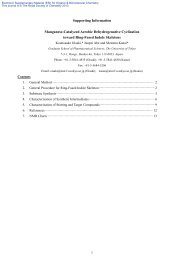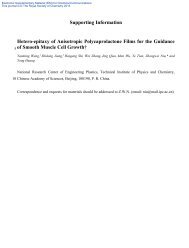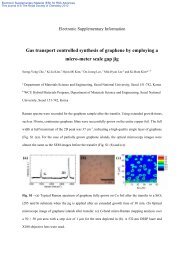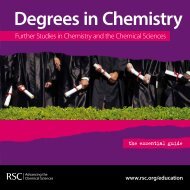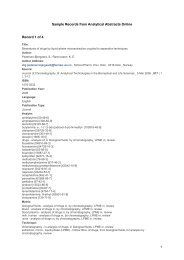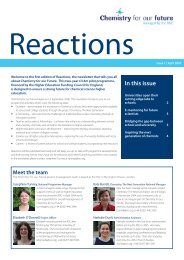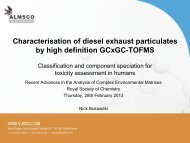Representation of Ethnic Groups in Chemistry and Physics
Representation of Ethnic Groups in Chemistry and Physics
Representation of Ethnic Groups in Chemistry and Physics
You also want an ePaper? Increase the reach of your titles
YUMPU automatically turns print PDFs into web optimized ePapers that Google loves.
4: The educational pipel<strong>in</strong>e<br />
4: The educational pipel<strong>in</strong>e<br />
“The black<br />
Caribbean ethnic<br />
group has the<br />
lowest overall<br />
survival rate <strong>in</strong><br />
academic<br />
chemistry <strong>and</strong><br />
physics.”<br />
Fig. 1 (opposite):<br />
Overall survival rates<br />
<strong>and</strong> stage survival rates<br />
<strong>in</strong> academic chemistry.<br />
14. For a general guide to<br />
def<strong>in</strong>itions <strong>of</strong> ethnic groups, see<br />
http://www.statistics.gov.uk/<br />
about/ethnic_group_statistics/<br />
downloads/ethnic_group_<br />
statistics.pdf<br />
Note: the way <strong>in</strong> which “other”<br />
<strong>and</strong> “mixed” ethnicity are def<strong>in</strong>ed<br />
differs <strong>in</strong> the YCS <strong>and</strong> HESA, mak<strong>in</strong>g<br />
any l<strong>in</strong>k<strong>in</strong>g <strong>of</strong> the two data<br />
sets impracticable for these<br />
groups.<br />
15. The over- or underrepresentation<br />
is calculated us<strong>in</strong>g<br />
the formula 100((overall survival<br />
rate <strong>of</strong> ethnic group at stage X/<br />
overall survival rate <strong>of</strong> white group<br />
at stage X)–1).<br />
16. These percentages can be<br />
thought <strong>of</strong> as quasi-probabilities<br />
(i.e. the probability <strong>of</strong> a<br />
representative <strong>in</strong>dividual<br />
rema<strong>in</strong><strong>in</strong>g <strong>in</strong> academic chemistry<br />
or physics at each stage). Note<br />
also that the rate <strong>of</strong> attrition can<br />
be calculated on this basis as<br />
100% m<strong>in</strong>us the rate <strong>of</strong> retention.<br />
The metaphor <strong>of</strong> the leaky educational pipel<strong>in</strong>e is now summarised<br />
for each <strong>of</strong> the ma<strong>in</strong> ethnic groups. 14 The population<br />
mov<strong>in</strong>g through the pipel<strong>in</strong>e start<strong>in</strong>g with a (notional)<br />
school-leav<strong>in</strong>g cohort gradually dim<strong>in</strong>ishes <strong>in</strong> mov<strong>in</strong>g from<br />
stages 1 to 6. The retention/attrition at each stage is the<br />
key consideration <strong>in</strong> assess<strong>in</strong>g when <strong>and</strong> how students<br />
“drop out” <strong>of</strong> academic studies <strong>in</strong> chemistry <strong>and</strong> physics, by<br />
ethnic group. The data are presented <strong>in</strong> three different ways:<br />
● Progress through the pipel<strong>in</strong>e is summarised by<br />
report<strong>in</strong>g the number <strong>of</strong> students rema<strong>in</strong><strong>in</strong>g, based on<br />
a notional cohort <strong>of</strong> 10 000 school-leavers per ethnic<br />
group. This figure gives the overall survival rate.<br />
● At each stage the overall over- or under-representation<br />
<strong>of</strong> each ethnic-m<strong>in</strong>ority group relative to the majority<br />
white population is reported. In other words,<br />
comparisons are reported between the overall survival<br />
rate <strong>of</strong> the majority white population <strong>and</strong> the overall<br />
survival rate <strong>of</strong> a particular ethnic group. 15<br />
● For each stage the proportion <strong>of</strong> each group mov<strong>in</strong>g<br />
through from the previous stage is expressed as a<br />
percentage based on the number <strong>of</strong> people surviv<strong>in</strong>g<br />
relative to that at the previous stage. 16 This is the stage<br />
survival rate <strong>in</strong> mov<strong>in</strong>g from one stage to the next.<br />
Figure 1 illustrates the leakage <strong>in</strong> chemistry, show<strong>in</strong>g the<br />
survival rates <strong>in</strong> chemistry based on a notional cohort <strong>of</strong><br />
10 000 school-leavers per ethnic group, as well as the rates<br />
<strong>of</strong> retention at each stage. Similarly, figure 2 describes the<br />
pipel<strong>in</strong>e for studies <strong>in</strong> physics.<br />
The emerg<strong>in</strong>g picture is quite complex, so the pipel<strong>in</strong>e is<br />
best described by means <strong>of</strong> an example based on the black<br />
Caribbean school-leavers. This group has the lowest overall<br />
survival rate <strong>in</strong> academic chemistry <strong>and</strong> physics, with<br />
only one student <strong>in</strong> 10 000 expected to undertake a doctorate<br />
degree <strong>in</strong> chemistry <strong>and</strong> fewer than one student <strong>in</strong><br />
10 000 expected to undertake a doctorate degree <strong>in</strong><br />
physics. The key question is therefore: where are the ma<strong>in</strong><br />
attrition po<strong>in</strong>ts for this group?<br />
This question is answered with reference to the white<br />
population (which can be used as a benchmark).<br />
First, black Caribbean students on average are much less<br />
likely to achieve five or more GCSEs at grade A*–C than<br />
their white counterparts. Only 29.2% <strong>of</strong> black Caribbean<br />
students achieve this benchmark, whereas the correspond<strong>in</strong>g<br />
figure for Engl<strong>and</strong>- <strong>and</strong> Wales-domiciled white<br />
students is 49.5%. There is an overall under-representation<br />
<strong>of</strong> black Caribbean students at this stage (41%) relative<br />
to the white majority group. In this <strong>in</strong>stance it is likely to<br />
be the result <strong>of</strong> external <strong>in</strong>fluences that have little to do with<br />
the study <strong>of</strong> science, such as socioeconomic factors, experiences<br />
<strong>of</strong> compulsory school<strong>in</strong>g <strong>and</strong> parental <strong>in</strong>put.<br />
Although these factors may be exogenous as far as the science<br />
community is concerned, many black Caribbean students<br />
fall at this first hurdle <strong>and</strong> therefore never have the<br />
opportunity to make positive choices regard<strong>in</strong>g the study<br />
<strong>of</strong> science. In this respect, lack <strong>of</strong> atta<strong>in</strong>ment at GCSE level<br />
alone potentially goes a long way to expla<strong>in</strong><strong>in</strong>g the lack <strong>of</strong><br />
black Caribbean scientists at university.<br />
There appear to be two other key po<strong>in</strong>ts <strong>of</strong> attrition for<br />
black Caribbean students. The first is <strong>in</strong> choos<strong>in</strong>g A-levels.<br />
Figures 1 <strong>and</strong> 2 show that black Caribbean students are<br />
much less likely to take A-level chemistry or physics than<br />
white students. Of the population <strong>of</strong> white students achiev<strong>in</strong>g<br />
five or more GCSEs at grade A*–C, approximately 10%<br />
go on to do an A-level <strong>in</strong> chemistry or physics. These figures<br />
compare with only 6% (chemistry) <strong>and</strong> 3% (physics) for the<br />
black Caribbean population. Black Caribbean students<br />
appear to f<strong>in</strong>d physical science unattractive even when<br />
choos<strong>in</strong>g A-levels.<br />
There is also a high level <strong>of</strong> attrition dur<strong>in</strong>g undergraduate<br />
studies. Black Caribbean students are much less likely to<br />
achieve a first- or upper-second-class degree than their<br />
white counterparts. The data show that this observation<br />
also applies <strong>in</strong> most other subject areas. For white students,<br />
53% <strong>of</strong> those study<strong>in</strong>g chemistry <strong>and</strong> 54% <strong>of</strong> those study<strong>in</strong>g<br />
physics obta<strong>in</strong> a first- or upper-second-class degree.<br />
This compares with 36% <strong>and</strong> 29% respectively for black<br />
Caribbean students. Moreover, <strong>of</strong> the students obta<strong>in</strong><strong>in</strong>g<br />
a first or upper-second, a smaller proportion <strong>of</strong> black<br />
Caribbean students go on to study chemistry or physics at<br />
doctorate level. This suggests that, even at university level,<br />
black Caribbean students appear to be deterred compared<br />
with their white peers.<br />
Complex picture<br />
The picture <strong>of</strong> retention/attrition across all ethnic groups<br />
is quite complex. Along with black Caribbean students,<br />
black African, Pakistani <strong>and</strong> Bangladeshi students are also<br />
less likely to achieve five or more GCSEs at grade A*–C<br />
compared with their white counterparts.<br />
Among ethnic-m<strong>in</strong>ority groups, only black Caribbean students<br />
appear to have a particular aversion to chemistry <strong>and</strong><br />
physics at A-level.<br />
This po<strong>in</strong>t is illustrated by compar<strong>in</strong>g the stage survival<br />
rates for black Caribbean students with those for other<br />
groups. The cumulative effects <strong>of</strong> small numbers <strong>of</strong> black<br />
Caribbean students achiev<strong>in</strong>g five GCSEs at grades A*–C,<br />
<strong>and</strong> a low take-up <strong>of</strong> A-level chemistry <strong>and</strong> physics, is illustrated<br />
by the overall under-representation <strong>of</strong> black<br />
Caribbean students at stage 2 <strong>of</strong> the educational pipel<strong>in</strong>e<br />
(–66% for chemistry; –83% for physics).<br />
8 R EPRESENTATION OF E THNIC G ROUPS IN C HEMISTRY AND P HYSICS M AY 2006




